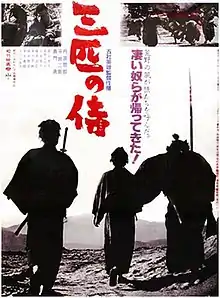Three Outlaw Samurai
Three Outlaw Samurai (三匹の侍, Sanbiki no Samurai) is a 1964 Japanese chambara film by director Hideo Gosha.[2]
| Three Outlaw Samurai | |
|---|---|
 | |
| Directed by | Hideo Gosha |
| Produced by | Ginichi Kishimoto Tetsuro Tamba |
| Written by | Keiichi Abe Eizaburo Shiba Hideo Gosha |
| Starring | Tetsuro Tamba Isamu Nagato Mikijirō Hira Yoshiko Kayama |
| Music by | Toshiaki Tsushima |
| Cinematography | Tadashi Sakai |
| Edited by | Kazuo Ota |
Production company | |
Release date |
|
Running time | 93 minutes |
| Country | Japan |
| Language | Japanese |
The film is an origin-story offshoot of the original Japanese television series of the same name. The film involves a wandering ronin (Tetsuro Tamba) who finds himself involved with two other samurai (Isamu Nagato and Mikijiro Hira) who are hired to execute a band of peasants who have kidnapped the daughter of a corrupt magistrate.[2]
Cast
- Tetsuro Tamba as Sakon Shiba
- Isamu Nagato as Kyojuro Sakura
- Mikijirō Hira as Einosuke Kikyo
- Yoshiko Kayama as Oyasu
- Kyoko Aoi as Omitsu
- Hisashi Igawa as the Magistrate
- Kamatari Fujiwara as Jinbê
Release
The film was released in Japan in 1964. On February 14, 2012, the Criterion Collection released a DVD and Blu-ray of the film.[2]
Reception
Bilge Ebiri, commissioned by Criterion Collection to write an essay on the film, wrote:[3]
"Three Outlaw Samurai is a supremely confident big-screen debut, whose surface simplicity masks a scathing vision of society lurking beneath. In some ways, it recalls Kurosawa's samurai narratives, with its tale of renegade rōnin who come to the aid of the dispossessed. But Gosha's personal obsessions are all over the film, particularly in his depiction of the loss of honor through blind loyalty (and its liberating opposite, the regaining of honor by betrayal), and in the sharp contrast he makes between the refined, comforting worlds of power and social duty and the wild, almost animalistic existence of those who choose freedom. And unlike Kurosawa, whose characters tend to be classically drawn and endlessly layered, Gosha often works in broad strokes: his characters are archetypes, which he then deconstructs and plays off one another. A samurai can go from fighting alongside a group to fighting against them in one brief shot, as in Three Outlaw Samurai. These characters may be simple, but Gosha’s real interest is in the portrait of society he is creating—and that is anything but."
Glenn Erickson, in an article for Turner Classic Movies published after the Criterion Collection Blu-ray release, wrote:[4]
"[I]t's an impressively well-told story with interesting characters and a surprise in every scene. Gosha and his writers Keiichi Abe and Eizaburo Shiba work clever games with the standard samurai archetypes: all are present, yet they refuse to accept their traditional roles. Gosha's thriller soon lets us know that it is not going to be yet another simplistic morality play about honor and loyalty....[Gosha] makes Three Outlaw Samurai a thorough critique of authoritarian society and the traditional honor code of the samurai. In Gosha's view the oppressive forces are money, power and class. The magistrate subscribes to no code except his own convenience and prestige. The only honor to be found in is therefore the opposition of unjust authority."
Rian Johnson has said that Three Outlaw Samurai influenced the writing of his Star Wars film The Last Jedi.[5]
References
- https://www.imdb.com/title/tt0058652/releaseinfo?ref_=tt_ov_inf
- "Three Outlaw Samurai". Criterion Collection. Retrieved November 15, 2011.
- Ebiri, Bilge (February 14, 2012). "Three Outlaw Samurai: The Disloyal Bunch". Criterion Collection. Retrieved 2013-12-04.
- Erickson, Glenn. "Three Outlaw Samurai - The 1964 Debut Film of Hideo Gosha". Turner Classic Movies. Retrieved 2013-12-04.
- Kamp, David (May 24, 2017). "Star Wars: The Last Jedi, the Definitive Preview". Vanity Fair. Retrieved 2017-12-11.
External links
- Three Outlaw Samurai at AllMovie
- Three Outlaw Samurai at IMDb
- Three Outlaw Samurai: The Disloyal Bunch an essay by Bilge Ebiri at the Criterion Collection